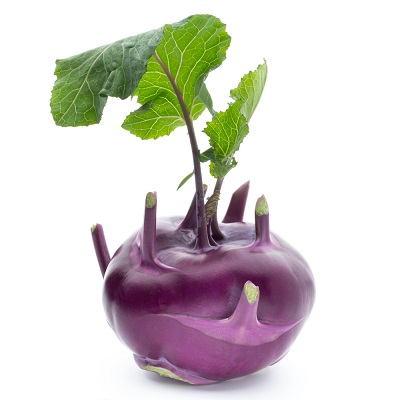 Most people don’t recognize how healthful kohlrabi is and that they can grow them in their own gardens. While kohlrabi is native to Europe, it can grow well in any temperate climate throughout the world. It is rich in nutrition and very low in calories.
Most people don’t recognize how healthful kohlrabi is and that they can grow them in their own gardens. While kohlrabi is native to Europe, it can grow well in any temperate climate throughout the world. It is rich in nutrition and very low in calories.
What is Kohlrabi Like?
Kohlrabi is a tuberous vegetable related to kale, collard greens, cabbage, Brussels sprouts and broccoli, all being members of the Brassica family of vegetables.
The round stem or tuberous part of the vegetable is eaten along with the leaves, which taste a lot like turnip leaves, a perennial vegetable that comes up every year in the same spot. It comes in purple and white varieties.
Kohlrabi can be picked and eaten raw. The greens can be sautéed with other greens and eaten with healthful results. There are salads that call for some cubed kohlrabi, in which you cube the bulbous stem and serve it raw with a bunch of other salad greens. Kohlrabi also makes a great vegetable for juicing, and goes great with green apples, lemons, beets and Kale.
How to Grow Kohlrabi
You need to plant your kohlrabi in fertile soil (preferably organic) that drains well and gets a medium amount of sun. The thick stem is ready to eat after about 2 months with an individual weight of about 150 grams. If you are not ready to eat the kohlrabi and you want it to stay in the fertile soil for a while, you can keep it in the ground for up to 30 days after it matures.
Kohlrabi taste and feel a lot like eating cubed broccoli stems or cabbage leaves but they don’t taste as strong and are sweeter when eaten. If you eat the stems before they are completely ripe, they are extremely crispy and have a lot of sweet, rich flavor.
While they come in white and purple varieties, the inside of the stems are about the same color—a creamy, white color. The inside of the stems is the tastiest part as the outer part can be somewhat tough to chew.
What are the Health Benefits of Kohlrabi?
Kohlrabi is also called Khol-khol or German Turnip has only about 27 calories in about 100 grams of fleshy inside. It contains no cholesterol and only a tiny bit of plant-based fat.
When you eat them freshly picked, they have a lot of vitamin C in them—about 62 mg per 100 grams of flesh. Vitamin C is an excellent antioxidant that helps your connective tissue stay strong and healthy. Your teeth, gums and other tissue are healthier when you eat kohlrabi.
As a great antioxidant, it scavenges for oxygen free radicals, which are harmful molecules that contain an extra electron. The presence of the extra electron causes it to damage surrounding molecules so it can damage just about any part of the cell. When it damages the DNA of cells, it can lead to many different diseases, including cancer. We make oxygen free radicals as part of cellular metabolism all the time so having antioxidants to neutralize these molecules is a good thing.
Kohlrabi contains essential phytochemicals such as Sulforaphane, isothiocyanates, and indole-3-carbinol, each of which has been found by research to help protect people against colon cancer and prostate cancer.
It also contains many of the B vitamins, including vitamin B6, niacin, thiamin, and pantothenic acid. These are important cofactors to many enzymes used inside the body for cellular metabolism.
Kohlrabi contains many different healthful minerals including potassium, calcium, iron, copper, manganese, and phosphorus, particularly in its bulbous stem. Potassium is especially important within the cell itself and it helps regulate the heart rate and blood pressure. Manganese is a necessary cofactor in the use of the enzyme called superoxide dismutase, which is an antioxidant.
Add these minerals to vitamin A and beta-carotenes and you have an all-around healthy vegetable that is sweet and tasty eaten any way.
Don’t Forget the Kohlrabi Leaves
These are like the greens on turnips and contain a lot of beta-carotene, vitamin K, minerals, vitamin A, and the B complex vitamins. These greens are best eaten raw in a salad or quickly sautéed and eaten right away for the best nutrition.






